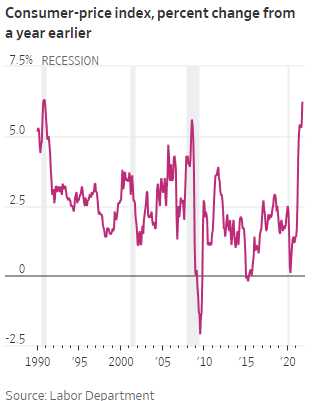6.2%. That was the jump in the Consumer Price Index, which measures what consumers pay for goods and services, from last October. Even worse, the Core CPI, which excludes food and energy, was up 4.6% – miles over the Fed's 2% price target. That's the fastest 12-month change since 1990 and our 5th consecutive month topping 5%. On a monthly basis, the CPI increased a seasonally adjusted 0.9% in October from the prior month, a sharp acceleration from September’s 0.4% rise and the same as June’s 0.9% pace. Price increases were broad-based, with higher costs for new and used autos, gasoline and other energy costs, furniture, rent and medical care while prices fell for airfare and alchohol – saving us from a total disaster – for now. Consumer spending increased at an annual rate of 1.6% in the third quarter , a sharp slowdown from a 12% increase in the prior quarter. However, much of that deceleration was due to scarcity of new cars and other durable goods. Consumer spending on services last quarter climbed at the brisk annual rate of 7.9%. Businesses are also passing on higher costs to consumers. 60% of small-business owners said they had raised prices in the previous 90 days. 80% of the companies surveyed reported higher labor costs, while 72% said vendors had increased prices and more than half experienced higher costs for raw materials and other inputs. We still have labor shortages, shipping shortages, chip shortages, auto shortages… – this stuff is not going to go away but the Fed continues do downplay the situaion, which is a polite way of saying they are lying to us. How can it be a good thing when the Fed is lying? They are lying to give themselves and excuse to continue a policy (QE + ZIRP) that is at the root of this inflationary catastrophe. The dearth of workers needed to meet consumer demand is also putting upward pressure on wages, adding to companies’ motivations for raising prices to offset higher labor costs. Higher food and energy prices —driven up by pandemic-related production snags, weather and geopolitical factors—are also spurring inflation, said Richard F. Moody , chief economist at Regions Financial Corp. …
 6.2%.
6.2%.
That was the jump in the Consumer Price Index, which measures what consumers pay for goods and services, from last October. Even worse, the Core CPI, which excludes food and energy, was up 4.6% – miles over the Fed's 2% price target. That's the fastest 12-month change since 1990 and our 5th consecutive month topping 5%.
On a monthly basis, the CPI increased a seasonally adjusted 0.9% in October from the prior month, a sharp acceleration from September’s 0.4% rise and the same as June’s 0.9% pace. Price increases were broad-based, with higher costs for new and used autos, gasoline and other energy costs, furniture, rent and medical care while prices fell for airfare and alchohol – saving us from a total disaster – for now.
Consumer spending increased at an annual rate of 1.6% in the third quarter, a sharp slowdown from a 12% increase in the prior quarter. However, much of that deceleration was due to scarcity of new cars and other durable goods. Consumer spending on services last quarter climbed at the brisk annual rate of 7.9%. Businesses are also passing on higher costs to consumers. 60% of small-business owners said they had raised prices in the previous 90 days. 80% of the companies surveyed reported higher labor costs, while 72% said vendors had increased prices and more than half experienced higher costs for raw materials and other inputs.
We still have labor shortages, shipping shortages, chip shortages, auto shortages… – this stuff is not going to go away but the Fed continues do downplay the situaion, which is a polite way of saying they are lying to us. How can it be a good thing when the Fed is lying? They are lying to give themselves and excuse to continue a policy (QE + ZIRP) that is at the root of this inflationary catastrophe.
The dearth of workers needed to meet consumer demand is also putting upward pressure on wages, adding to companies’ motivations for raising prices to offset higher labor costs. Higher food and energy prices—driven up by pandemic-related production snags, weather and geopolitical factors—are also spurring inflation, said Richard F. Moody, chief economist at Regions Financial Corp.…

 6.2%.
6.2%. 